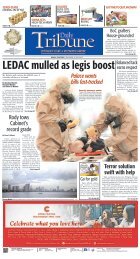Create successful ePaper yourself
Turn your PDF publications into a flip-book with our unique Google optimized e-Paper software.
Daily Tribune<br />
H<br />
SPOT<br />
MANILA BAY SPECIAL EDITION<br />
<strong>25</strong> March <strong>2019</strong><br />
Issue 6<br />
'NOT A LOST CAUSE'<br />
Most important mission<br />
AT A GLANCE<br />
Best harbor in the south<br />
EARTH TO ESTERO<br />
Volunteerism at its best<br />
'KAYA PALA'<br />
Power of political will
Daily Tribune<br />
2 <strong>25</strong> <strong>MARCH</strong> <strong>2019</strong> MANILA BAY<br />
SPECIAL EDITION<br />
EDITORIAL<br />
H<br />
WHAT’S INSIDE<br />
SPOT<br />
Kaya at puwede pala<br />
It was the first social media “challenge” that I accepted. On the morning of 27 January<br />
and with my family in tow, I drove to Roxas Boulevard to participate in what would be<br />
the most sustained and game-changing event, the rehabilitation of Manila Bay.<br />
Dubbed the “Battle for Manila Bay,” I wanted<br />
my children to join the clean-up drive to educate<br />
them about the significance of preserving and<br />
protecting nature and the environment to secure<br />
their future. It also helps that my children are<br />
environmentally aware.<br />
Never did I imagine this initiative of the<br />
Department of Environment and Natural<br />
Resources (DENR) under Secretary Roy A. Cimatu<br />
to bring back the old glory of the world-famous bay<br />
would spawn into a much larger effort and spark<br />
national interest to clean up not the metro’s many<br />
waterways. The initiative also served as a wakeup<br />
call – that it’s time to start caring about the<br />
environment.<br />
Immediately after the launch in Manila,<br />
simultaneous clean-up activities were held at<br />
the Las Piñas-Parañaque Critical Habitat and<br />
Ecotourism Area (LPPCHEA) and the Marine Tree<br />
Park in Navotas in the National Capital Region.<br />
In Region 3, volunteers in the towns of<br />
Obando, Bulacan, Mariveles, Bataan, Guagua,<br />
Pampanga also joined the rehabilitation initiative,<br />
while a similar activity was held at Talaba Dos in<br />
Bacoor, Cavite.<br />
Acting in unison, government agencies like<br />
the Departments of Tourism, Interior and Local<br />
Government, Social Welfare and Development,<br />
Trade and Industry, National Defense and Science<br />
and Technology joined the campaign.<br />
The Pasig River Rehabilitation Commission,<br />
Housing and Urban Development Coordinating<br />
Council, National Housing Authority, Presidential<br />
Commission for the Urban Poor, Manila Water<br />
Company Inc., Maynilad Water Services Inc.,<br />
various local government units, non-government<br />
organizations and other stakeholders also threw in<br />
their support.<br />
I drove by Roxas Boulevard to see<br />
the impact of the clean-up drive<br />
on the people of Metro Manila.<br />
What I saw almost made me cry<br />
Not surprisingly, a week after the launch, my<br />
daughter borrowed my car because her classmates<br />
from a university in Caloocan wanted to see the<br />
transformation of Manila Bay from what they read<br />
and saw from social media, news reports and other<br />
sources.<br />
Intrigued by the renewed interest in Manila<br />
Bay, I drove by Roxas Boulevard to see the impact<br />
of the clean-up drive to the people of Metro Manila.<br />
What I saw almost made me cry.<br />
Hundreds of people lining along the seawall<br />
fronting the Aristocrat Restaurant in Remedios all<br />
the way to the U.S. Embassy. There were even beach<br />
tents as people enjoyed the clean beach. Yes, there<br />
is now a beach there! There were students, police,<br />
workers and local and foreign tourists, enjoying<br />
the sweet smell of the sea and the beauty of Manila<br />
Bay’s sunset – minus the usual putrid smell from<br />
human feces and garbage.<br />
So, this is political will.<br />
For decades, past administrations have made<br />
similar actions to rid Manila Bay of pollution,<br />
but bringing it back to its pristine condition had<br />
been very slow. It took the will of the Duterte<br />
administration to bring something concrete and<br />
sustainable.<br />
Kapag ginusto, kaya at puwede pala.<br />
3 'Not a lost cause'<br />
Saving Manila Bay is the Filipinos'<br />
fight<br />
5 Environment "elite special forces"<br />
Barangay leaders play key role<br />
6 Manila Bay rehabilitation:<br />
A timeline<br />
What inspires the initiative<br />
8 Earth to estero<br />
Corporations "clean up their acts"<br />
10 Beyond sunsets, viewing the future<br />
Reflection on what is and could be<br />
STAFF<br />
Editors<br />
Dinah Ventura<br />
Jojo Silvestre<br />
Sub-Editor<br />
joseph Cortes<br />
Project Director<br />
Komfie Manalo<br />
Writers<br />
Gene Beatrice A. Micaller<br />
AJ Bajo<br />
Marketing and Advertising<br />
Ghie Datoy<br />
Graphic Artist<br />
Maritess Jamin<br />
Cover Art<br />
Remel "Ismit" Mendez<br />
Never did I imagine this initiative of<br />
Environment Secretary Roy A. Cimatu to bring<br />
back the old glory of the world-famous bay<br />
would spawn a much larger effort<br />
Komfie Manalo<br />
Daily Tribune<br />
H SPOT<br />
Concept & Information Group, Inc.<br />
3450 Concept Building, Florida Street,<br />
Makati City, Philippines 1235<br />
Telephone: +632-8310496<br />
Email: ads@tribune.net.ph<br />
www.tribune.net.ph / www.conceptnewscentral.com
Daily Tribune<br />
MANILA BAY<br />
H SPOT <strong>25</strong> <strong>MARCH</strong> <strong>2019</strong> 3<br />
SPECIAL EDITION<br />
'Not a lost cause'<br />
We are not only<br />
cleaning up the bay.<br />
We are saving something<br />
worth saving because<br />
if we allow it to die,<br />
more people might<br />
perish<br />
’CLEANING up is part of internal cleansing.’<br />
economic development.<br />
Indeed, the bay with its natural<br />
harbor hosts the Port of Manila and<br />
the Manila International Container<br />
Port which brings in 54 percent to the<br />
nation’s gross domestic product (GDP).<br />
“This is by far my most important<br />
mission,” he said, stressing it is a major<br />
source of fresh seafood for Metro<br />
Manila and nearby provinces.<br />
However, a dirty Manila Bay is a<br />
threat to food security.<br />
By Komfie Manalo<br />
On 27 January this year, more<br />
than 10,000 Filipinos<br />
marched not to the beat of<br />
war drums but to a strong<br />
resolve to rehabilitate<br />
Manila’s most beloved bay. The aim? To<br />
bring it back to its former glory in what<br />
will be known as the Sixth Battle for<br />
Manila Bay.<br />
Starting with a solidarity walk and<br />
armed only with shovels, pitchforks,<br />
garbage bags and even their bare<br />
hands, the volunteers coming<br />
from both the private and public<br />
sectors scoured the stretch of Roxas<br />
Boulevard from the US Embassy to the<br />
Philippine Navy headquarters. They<br />
had come for a noble cause: to pick<br />
up debris that littered the bay, even as<br />
planners from the government have<br />
devised a strategy to permanently<br />
clean Manila Bay and make its waters<br />
safe again.<br />
“Manila Bay is not a lost cause,”<br />
Environment Secretary Roy A. Cimatu<br />
said. “With the commitment and<br />
determination of every individual to<br />
This is a battle that will<br />
be won not with force or<br />
arms but with the firm<br />
resolve to bring Manila<br />
Bay back to life<br />
contribute to the rehabilitation, there is<br />
no doubt we will win this battle.”<br />
With the battlecry “Clean Manila<br />
Bay,” Cimatu said it is the moral<br />
responsibility of every Filipino to<br />
treasure Manila Bay as a natural<br />
resource and historically significant<br />
destination by working for its<br />
restoration.<br />
Historical clashes<br />
The first Battle for Manila Bay<br />
occurred in 1571 between Rajah<br />
Sulayman and the Spanish colonizers.<br />
The second was in 1647 between the<br />
Dutch and Spanish navies. In 1762,<br />
the third battle erupted when a British<br />
armada temporarily gained control of<br />
Manila from the Spaniards. In 1898,<br />
the fourth one ended the Spanish-<br />
American War with a mock battle, a<br />
moro-moro between American forces led<br />
by Admiral George Dewey and Spanish<br />
forces led by Rear Admiral Patricio<br />
Montojo.<br />
The orchestrated skirmish saw the<br />
transfer of control of the Philippines<br />
from the Spaniards to the Americans<br />
after the latter paid $20 million to<br />
Spain.<br />
The fifth major battle in Manila Bay<br />
occurred in 1945 when the Americans<br />
launched an offensive to liberate the<br />
Philippines from its Japanese occupiers.<br />
Over 100,000 of Manila’s sons and<br />
daughters lost their lives during the<br />
month-long battle, with the city losing<br />
most of its architectural and cultural<br />
heritage dating back to the Spanish<br />
period.<br />
Latest battle<br />
However, the Environment Chief<br />
considers the latest battle as the<br />
toughest of them all because it involves<br />
the revitalization of the Philippines as a<br />
nation.<br />
“Cleaning up Manila Bay is part<br />
of our internal cleansing. In cleaning<br />
Manila Bay, we are also embarking on<br />
a culture change – doing away with<br />
the bad habit of throwing garbage and<br />
degrading our environment,” Cimatu<br />
said.<br />
“Manila Bay had been a treasure<br />
for many generations past. Let us keep<br />
it a treasure for ourselves and for those<br />
who will come after us,” he added,<br />
stressing how the bay is an integral part<br />
of Filipino culture, as well as a major<br />
contributor to the country’s social and<br />
Not impossible<br />
For his part, DENR Undersecretary<br />
Benny D. Antiporda pointed out the lack<br />
of discipline among Filipinos as the<br />
single biggest obstacle to the success of<br />
the rehabilitation.<br />
“We are looking at one major<br />
stumbling block – it is the lack of<br />
discipline among our countrymen,”<br />
Antiporda said. “What we need is<br />
discipline.”<br />
He added: “We are not only cleaning<br />
up the bay. We are saving something<br />
worth saving because if we allow it to<br />
die, more people might perish.”<br />
In 2008, the Supreme Court issued<br />
a mandamus directing the DENR and<br />
12 other government agencies to clean<br />
up, rehabilitate and preserve Manila Bay<br />
THOUSANDS flocked to the Quirino Grandstand with one goal. Manila Bay is not a lost cause.<br />
Turn to page 4
Daily Tribune<br />
4 <strong>25</strong> <strong>MARCH</strong> <strong>2019</strong> MANILA BAY<br />
SPECIAL EDITION<br />
H<br />
SPOT<br />
From Page 3<br />
Not a lost...<br />
and to restore and maintain its water<br />
quality to a level fit for swimming and<br />
other contact recreation.<br />
Antiporda lamented how, in the<br />
last decade, the efforts of concerned<br />
agencies have not been visible or felt at<br />
all. He attributed previous unsuccessful<br />
efforts to “weak coordination and<br />
collaboration among agencies.”<br />
This time, however, he said the<br />
DENR and other government agencies<br />
have the full backing of President<br />
Rodrigo Duterte, allowing them to<br />
effectively enforce the law and ensure<br />
compliance of local government<br />
units with their mandate towards<br />
environmental protection.<br />
He added the DENR is coming up<br />
with interventions that would hasten<br />
the improvement of Manila Bay’s water<br />
quality. At the same time, he allayed fears<br />
that the rehabilitation would result in<br />
the loss of jobs and livelihood within the<br />
Manila Bay area.<br />
Boracay redux<br />
Cimatu agreed with Antiporda<br />
and cited the efforts of the DENR<br />
to rehabilitate Boracay which many<br />
naysayers doubted but the agency proved<br />
them wrong.<br />
“We can restore back the once<br />
clean and beautiful bay if we all believe<br />
that we can do it. We are not alone.<br />
We have the mandamus agencies and<br />
The DENR and other government<br />
agencies have the full backing<br />
of President Rodrigo Duterte,<br />
allowing them to effectively<br />
enforce the law<br />
and ensure compliance<br />
of local government units<br />
different stakeholders on our side – the<br />
national and local government agencies,<br />
the government and non-government<br />
institutions and civil society,” he added.<br />
After the launch, the DENR issued<br />
a 10-point “Pledge to the Environment.”<br />
The pledge includes nurturing<br />
everything that God had created as well<br />
as protecting the county which is the<br />
cradle to our future.<br />
“I pledge that I will protect humanity<br />
by preserving the environment,” the<br />
document says. “I pledge to keep my<br />
community clean as its responsible<br />
member.”<br />
Moreover, it invokes a promise<br />
to encourage one’s family, relatives,<br />
friends and neighbors to prioritize the<br />
protection of nature.<br />
MORE than 10,000 volunteers answered the call.<br />
YOUTH representative Angel Delfin leads government officials and thousands of participants in reciting the Sampung Panunumpa para sa Kalikasan (Pledge to the Environment).
Daily Tribune<br />
MANILA BAY<br />
H SPOT <strong>25</strong> <strong>MARCH</strong> <strong>2019</strong> 5<br />
SPECIAL EDITION<br />
Environment ‘elite special forces’<br />
BASECO residents joined forces in cleaning up Baseco Beach, one of the nine critical rivers that need to be cleaned as part of the restoration effort.<br />
PHOTO BY BOB DUNGO, JR.<br />
By Komfie Manalo<br />
In the campaign to save Manila Bay, barangay leaders<br />
are the environment’s “elite special forces” or even “the<br />
most powerful public officials in the country” in enforcing<br />
the law and protecting the community<br />
Environment Secretary Roy A. Cimatu said as much<br />
during a dialogue with barangay leaders. He said barangay<br />
officials, particularly in the areas around Manila Bay, play a<br />
crucial role in bringing the heavily polluted bay back to its<br />
former glory.<br />
“The barangay leaders and members who are here<br />
today could be considered special forces in this endeavor,”<br />
the former military chief quipped.<br />
Cimatu added the government is relying on these local<br />
leaders whose support and cooperation are vital in ensuring<br />
the success of the rehabilitation dubbed the<br />
“Battle for Manila Bay,” given their proximity<br />
to nine critical rivers that need to be<br />
cleaned as part of the restoration<br />
effort.<br />
“As much as you are the ones<br />
nearest to the rivers or the battle<br />
areas, you are also the ones<br />
closest to the people who are<br />
possible enemies or violators,”<br />
the Environment chief said.<br />
“Influence them to stop their<br />
bad practices of dumping garbage<br />
anywhere and ask them to join you as<br />
volunteers in your cleaning campaign<br />
drive.”<br />
As much as you are the ones nearest<br />
to the rivers or the battle areas,<br />
you are also the ones closest to the people<br />
who are possible enemies or violators.<br />
He added: “Your mission is special. Kaya isa kayo sa<br />
mga elite forces ng (You are the elite forces of the) Manila<br />
Bay rehabilitation. Consider yourselves as the first line of<br />
defense.”<br />
The dialogue aimed to remind the barangay executives<br />
of their role in the rehabilitation effort, as well as their<br />
responsibility in cleaning up rivers that empty into Manila<br />
Bay.<br />
‘Call of nature’<br />
Sherwin S. Rigor, DENR undersecretary for attached<br />
agencies and supervising undersecretary for Manila<br />
Bay Coordinating Office (MBCO), thanked the village<br />
chief executives for answering the call since the Duterte<br />
administration launched the Manila Bay rehabilitation.<br />
He said the barangay units as well as their constituents<br />
have accepted the challenge and are one with the<br />
government in the massive undertaking of clearing<br />
the waterways around Metro Manila, including<br />
rivers, esteros, creeks and canals that<br />
ultimately dump water into the bay.<br />
“With your support, we will make the<br />
water of Manila Bay safe,” Rigor told the<br />
attendees in the dialogue. He added public<br />
support is the key to the success of the<br />
rehabilitation program.<br />
Pollution hotspot<br />
Cimatu said barangay leaders should be<br />
“vigilant” for issues concerning the rivers in<br />
their areas of jurisdiction.<br />
He noted, for example, that Manila Bay has<br />
become a “pollution hotspot” in southern part of East<br />
Asia, making it a “potential health hazard to our people, a<br />
threat to the nation’s food security and a tremendous impact<br />
to the country’s biodiversity.”<br />
Despite this, Cimatu believes the Manila Bay<br />
rehabilitation is not an impossible mission if everyone<br />
will take part in the undertaking. “We can restore the once<br />
clean and beautiful bay if we all believe that we can do it,” he<br />
encouraged.<br />
“We are not alone. We have the mandamus agencies<br />
and different stakeholders on our side: the national and<br />
local government agencies, the government and nongovernment<br />
institutions, and the civil society,” he added.<br />
Last 27 January, the DENR launched the three-phase<br />
“Battle for Manila Bay” project where over 10,000 people<br />
joined a massive clean-up activity on Roxas Boulevard in<br />
Manila and other parts of the Manila Bay region.<br />
More than a month since the launch, the DENR<br />
has already issued a total of 263 notices of violation and<br />
119 cease and desist orders to establishments in Metro<br />
Manila, Central Luzon and Calabarzon that violated the<br />
Philippine Clean Water Act of 2004 and other pertinent<br />
environmental laws.<br />
Act or be gone<br />
In the same dialogue, Department of Interior and<br />
Local Government (DILG) Undersecretaries Epimaco V.<br />
Densing III and Martin B. Diño warned barangay chief<br />
executives they would face administrative charges or<br />
even termination from office if they fail to clean up their<br />
localities and participate in the efforts to do the same to<br />
waterways.<br />
In a stern warning, Densing and Diño told local leaders<br />
they need to comply with the directive of Interior and Local<br />
Government Secretary Eduardo M. Año to conduct a weekly<br />
clean-up of waterways in their jurisdictions.<br />
“If you do not want to do your job then you should quit<br />
[as barangay chairmen],” Densing said as he reiterated the<br />
call for public servants to comply with their mandate of<br />
protecting the environment.<br />
“I urge you to use your funds to enforce the law,” said<br />
Diño, who served as barangay chairman for more than 10<br />
years before his appointment to national position.<br />
He added: “Secretary Año had issued show cause<br />
orders to at least 1,000 barangay officials in Luzon to<br />
compel them to submit a report on their clean-up of esteros,<br />
creeks, rivers and other waterways in their localities.<br />
“The majority of garbage is coming from domestic<br />
sources. Those are your constituents and you should<br />
implement environmental laws. Remember, Republic Act<br />
9003 makes it a criminal act to litter or throw garbage<br />
improperly. Violators of this law are criminals,” he said.
Daily Tribune<br />
6 MANILA BAY<br />
<strong>25</strong> <strong>MARCH</strong> <strong>2019</strong><br />
SPECIAL EDITION<br />
H<br />
SPOT<br />
Daily Tribune<br />
Daily Tribune<br />
MANILA BAY<br />
MANILA BAY<br />
H SPOT <strong>25</strong><br />
H<strong>MARCH</strong> SPOT<br />
<strong>2019</strong> 7<br />
SPECIAL EDITION<br />
SPECIAL EDITION<br />
CHILDREN residing in the bay area<br />
flock to Manila Bay for a swim.<br />
By Gene Beatrice A. Micaller<br />
On 16 December 2018, the Department of Environment and Natural Resources (DENR), using the<br />
same strategy it implemented in the renewal of Boracay Island, decided to begin the rehabilitation<br />
of one of the metro’s most popular tourist spots – the Manila Bay.<br />
Known for its eye-catching golden sunset, Manila Bay had become notorious for its polluted waters as<br />
a result of improper and indiscriminate dumping of toxic waste from factories and shipping operations,<br />
garbage and sewage.<br />
“We are preparing for an all-out strategy to bring the coliform concentration in Manila Bay to a safe<br />
level, so that millions of people who reside in the bay region and neighboring areas will enjoy its waters<br />
and marine resources without fear of getting sick,” said Environment Secretary Roy A. Cimatu of that<br />
first meeting.<br />
Reports from the agency showed the fecal coliform level in the bay was at 330 million MPN/100ml,<br />
exceeding the maximum safe level of 100 MPN/100ml.<br />
“I am calling on all LGU (local government units) to step up their efforts in cleaning up the bay,<br />
because it is their own constituents who will benefit (from a rehabilitated Manila Bay),” Cimatu stressed.<br />
To address this long-overdue problem, the DENR decided that among the first steps it should<br />
implement is to control the amount of pollutants and waste being discharged into the bay’s waters.<br />
On 12 January, the agency started the strict enforcement of Republic Act 9275 or the Philippine<br />
Clean Water Act of 2004, which focuses on “addressing water quality issues and other environmental<br />
problems in the historic bay.”<br />
On the same day, Cimatu inspected the Estero de San Antonio de Abad in Malate, Manila where<br />
wastewater is being unloaded. This was done to determine the source of untreated wastewater being<br />
discharged into Manila Bay.<br />
As a result, a number of establishments were given notice to set up their own sewage treatment<br />
plant (STP) to reduce contamination of seawater.<br />
“We are giving them three months to put up their own STP,” he added.<br />
The Environment Chief outlined a three-phased Manila Bay rehabilitation program. Phase 1<br />
includes the clean-up and improvement of the bay’s water quality. Rehabilitation comes in Phase 2,<br />
while the last phase would cover its protection and making it sustainable.<br />
On 15 January, he called on all the business owners to work hand-in-hand with the agency<br />
to regain the once picturesque bay and become part of its history. “I wish you join us in making<br />
history in our country,” he said.<br />
Cimatu, along with the Interior and Tourism Secretaries, led the meeting that tackled the<br />
mission to bring back Manila Bay to its old form.<br />
“This mission is not impossible. This mission calls for dedication and hard work from all<br />
those who will help us in this operation,” he expressed.<br />
The agency kicked-off the effort by identifying the establishments that did not conform to<br />
the country’s environmental laws.<br />
“I assure you that it will happen,” he explained. “We will not only clean it, but we will also be<br />
able to do something better for our countrymen and the next generation.”<br />
Two days after calling the support of stakeholders, Cimatu said that in order to fulfill the<br />
vision of a spick-and-span Manila Bay, they were joining forces with anyone who also has the<br />
same vision as theirs – to sanitize all bodies of water that lead to the bay.<br />
“We need to find out where the outfalls come from individually, because in just one estero<br />
we can find lots of outfalls,” he pointed out.<br />
Likewise, he stated the facilities of concessionaires Maynilad and Manila Water, which<br />
supply water to both residential and commercial establishments in Metro Manila, were also<br />
going to be inspected.<br />
On 19 January, Cimatu assured that bringing Manila Bay to its old glory was not totally<br />
“mission impossible,” so long as every concerned citizen will partake in the project.<br />
DENR Undersecretary Benny D. Antiporda identified the biggest hurdle to the project<br />
to be the lack of discipline among Filipinos.<br />
“What we really need is discipline,” he said.<br />
He explained they “are not only cleaning up the bay. We are saving something that is<br />
already on the verge of dying because, if we don’t, more and more people will die.”<br />
In 2008, the Supreme Court issued a mandamus mandating the DENR and 12 other<br />
government agencies to rehabilitate and preserve the Manila Bay. Unfortunately, for the<br />
past 10 years, the efforts of the mandamus agencies were not felt by the nation.<br />
This mission is not impossible. This mission<br />
calls for dedication and hard work from all<br />
those who will help us in this operation<br />
Antiporda said it is different this time around.<br />
With the comprehensive support of President Rodrigo<br />
R. Duterte, the agency is confident that it can effectively lay out<br />
everything for the rehabilitation of Manila Bay.<br />
He admitted that, as work progresses, it is expected that more<br />
and more livelihoods and jobs within the bay zone will be affected.<br />
After declaring not to be “mission impossible,” Cimatu<br />
appealed for government establishments to lead by example. He<br />
said government offices should be at the forefront of complying<br />
with environmental laws, particularly the Clean Water Act of 2004<br />
and the Ecological Solid Waste Management Act of 2000.<br />
“Manila Bay is in critical condition and proper wastewater<br />
discharge and solid waste disposal play key roles to reviving it,” he<br />
said.<br />
Establishments that will be caught overlooking the said<br />
environmental laws may face termination of their licenses to<br />
operate and pay a fine of as much as P200,000 a day.<br />
“We will issue notices of violation to non-compliant<br />
establishments, or we will shut them down,” he stressed. “Until they<br />
comply, they cannot operate.”<br />
Cimatu also cited the need to educate residents, especially<br />
informal settlers, to segregate their wastes before discharging them<br />
into bodies of water.<br />
“With education, we can clean up Manila Bay. We can sustain<br />
it, and we can preserve the revived Manila Bay,” he said.<br />
The more difficult part is the relocation of<br />
over 220,000 households. But the most<br />
difficult is to maintain and sustain its clean<br />
condition for the next generation<br />
On <strong>25</strong> January, DENR said the real “Battle for Manila Bay”<br />
would be starting. The rehabilitation agenda would see the combined<br />
forces of more than 5,000 participants, with most coming from the<br />
DENR and other government agencies.<br />
“This is a battle that will be won not with force or arms, but with<br />
the firm resolve to bring Manila Bay back to life,” he said.<br />
By 27 January, the DENR officially declared the onset of the<br />
Manila Bay rehabilitation program. On that same day, more than<br />
10,000 participants came together at the Solidarity Walk that<br />
stretches from the Quirino Grandstand to Baywalk, which also<br />
happened to be the staging area of the launch.<br />
“With the commitment and determination of every Filipino<br />
to do his share in this rehabilitation effort, we have already won the<br />
battle for Manila Bay,” Cimatu declared.<br />
Weeks after the launch, on 6 February, he stressed that to<br />
completely refurbish Manila Bay and preserve it for the long-term,<br />
the people need to observe some form of cultural change.<br />
“If they ask me what is the most difficult part in rehabilitating<br />
Manila Bay, I would say it is to change our people’s behavior and<br />
attitude,” he expressed.<br />
He shared that around 14 percent of the overall allocated P42<br />
billion budget for the program will be devoted to the clean-up activities<br />
alone. This amount is roughly equivalent to P6 billion. The remainder<br />
will be spent on the relocation of informal settlers and the provision of<br />
support systems, like improving access to jobs and livelihoods.<br />
“The more difficult part is the relocation of over 220,000<br />
households. But the most difficult is to maintain and sustain its clean<br />
condition for the next generation,” he said.<br />
Furthermore, with the health of Filipinos in mind, the DENR<br />
said the reduction of coliform levels in the bay is of top priority.<br />
“Bathing in Manila<br />
With the commitment and determination<br />
of every Filipino to do his share in this<br />
rehabilitation effort, we have already won<br />
the battle for Manila Bay<br />
Bay can expose people to high levels of fecal coliform bacteria,<br />
which could increase their chances of developing illnesses. The<br />
government has not yet given the all-clear signal for swimming,” he<br />
stated.<br />
The agency’s first few steps included the cleaning of the Baseco<br />
Compound in Tondo, Manila. On 11 February, the DENR collected<br />
550 sacks of garbage from the said location.<br />
This cleanup activity was part of the project of Task Force<br />
DENR Metro Manila (TF-DEMM), which is directly tasked to<br />
oversee the Manila Bay rehab.<br />
The next day, the agency urged municipality mayors to support<br />
them in the rehab program via the cleanup of rivers and esteros in<br />
areas that directly discharge waste into Manila Bay.<br />
"We have to clean all 47 esteros and all the rivers that contribute<br />
to the pollution of Manila Bay. None will be spared. We will go<br />
through them one by one,” Cimatu said during the Local Executives’<br />
Forum on the Manila Bay Cleanup, Rehabilitation and Preservation<br />
Program.<br />
Additionally, the DENR urged local government units to locate<br />
where the water pollution is<br />
coming from in their areas<br />
and take measures to<br />
resolve it.<br />
“Once we clean<br />
the esteros and rivers,<br />
garbage will not go out<br />
to Manila Bay. We’ll<br />
make it a point that<br />
the water that reaches<br />
Manila Bay is clean,”<br />
he stressed.<br />
He added, “It’s<br />
the mayors and<br />
the LGU who have<br />
the main authority over the signing of the contract with garbage<br />
collection contractors. I hope that after signing the contracts,<br />
the LGU check that contractors follow what is stipulated in the<br />
contract.”<br />
He also cited that of 220,000 informal settlers residing along<br />
esteros leading to Manila Bay, only 10,000 will be relocated in a year.<br />
On 20 February, 20 establishments in the cities of Pasay and<br />
Manila were found to be improperly disposing of their wastewater<br />
by the Laguna Lake Development Authority (LLDA). These included<br />
the Cultural Center of the Philippines and Overseas Workers<br />
Welfare Administration buildings, to name a few.<br />
Overall, 63 establishments were cited by the LLDA with<br />
violations ever since the start of the Manila Bay rehabilitation<br />
scheme on 27 January. It comprised 16 cease and desist orders, 12<br />
ex-parte orders and 35 notices of violations.<br />
On 24 February, Cimatu conceived an inter-agency Manila<br />
Bay Task Force to aid the agency in systemizing and hastening the<br />
efforts of the government to refurbish polluted bodies of water.<br />
This task force complied with Executive Order 16 signed<br />
by the President that would fortify “complete rehabilitation,<br />
restoration and conservation of the Manila Bay.”<br />
“This order will fast-track all the work we are doing, delineate<br />
responsibilities and coordinate activities of all government agencies<br />
involved in the rehabilitation efforts,” he explained.<br />
Other agencies and offices that are part of the task force are<br />
the chiefs of the Departments of Public Works and Highways and<br />
Agriculture, Housing and Urban Development Coordinating Council,<br />
Metropolitan Manila Development Authority, Pasig River Rehabilitation<br />
Commission, Local Water Utilities Administration, Manila Waterworks<br />
and Sewerage System, Philippine National Police Maritime Group,<br />
Philippine Coast Guard and Philippine Ports Authority. Manila Water<br />
and Maynilad were also made part of the task force.<br />
On 27 February, during the celebration of World Wildlife<br />
Day <strong>2019</strong>, Cimatu described this year’s theme to be timely and<br />
relevant: “Life Below Water: For People and Planet.”<br />
“This year’s celebration reminds us of the importance<br />
of marine life as one of the natural resources that we need to<br />
sustain, thus giving us more reasons to continue the ongoing<br />
efforts to save Manila Bay and other bodies of water in the<br />
Philippines,” he said.<br />
A DREDGING machine is used to dig waste<br />
under Manila Bay.<br />
Manila Bay rehabilitation: A timeline
Daily Tribune<br />
8 <strong>25</strong> <strong>MARCH</strong> <strong>2019</strong> MANILA BAY<br />
SPECIAL EDITION<br />
H<br />
SPOT<br />
By AJ Bajo<br />
Picture this: Microscopic buildings made of plastic all<br />
the familiar brands we consume and discard, rinse<br />
and repeat – standing vertically atop the sea foam,<br />
swishing along the world’s ocean gyres.<br />
Now, a little bit closer: Petite organisms squeezing their way into Styrofoam<br />
restaurants, munching on plastic brunches, whiling time away on chemical<br />
parks.<br />
The mess that we have made has grown so extensive, it might as well have<br />
created its own ecosystem.<br />
To help bring back the esteros (estuaries) to their earthly state, a<br />
collaboration between the estero communities, donor-partners, local government<br />
units, the Department of Environment and Natural Resources (DENR) and other<br />
government agencies gave birth to the Adopt-an-Estero/Water Body program.<br />
The DENR Environmental Management Bureau says one of the program’s<br />
objectives is to “clean the esteros of wastes, debris and silt starting 2010 until all<br />
have been cleaned up.”<br />
This primarily engages communities to maintain their waterways and<br />
“enlist their active participation in the actual clean-up, and in implementing and<br />
preparing plans to sustain a clean estero in the future years.”<br />
On the other hand, the DENR defined donors or partners as a “business<br />
establishment, an industry association, a non-government organization or any<br />
other group that volunteers to be a major actor in cleaning the esteros.”<br />
Some of DENR’s big-ticket partners for the program have included SM<br />
Prime Holdings and Petron, and lately San Miguel Corp.<br />
In 2011, Petron Corp. pledged P200 million to aid the rehabilitation of the<br />
Marikina River for five years.<br />
This effort included information and education campaigns, as well as<br />
engagements with local stakeholders to ensure the campaign’s sustainability.<br />
SM Prime likewise paired with the agency for a five-year rehabilitation<br />
program for the 10-kilometer stretch of the San Juan River in 2012.<br />
And just this March, SMC signed a memorandum of agreement to<br />
rehabilitate the Tullahan-Tinajeros River System, funding P1 billion for the<br />
equipment, which will be used for the clean-up of the river, starting with the<br />
stretch at the La Mesa Dam end in Quezon City.<br />
The Tullahan River traverses the cities of Malabon, Caloocan, Valenzuela<br />
and Quezon City, before emptying into glorious Manila Bay, which has since<br />
received renewed attention when thousands flocked here for a massive clean-up<br />
drive – and photo ops, too.<br />
Two years after the establishment in 2010 of the Adopt-an-Estero program,<br />
the DENR reported more than 300 partners who have lent a hand, time and<br />
effort to make the congested esteros great again.<br />
The effort is far from completion, and once the walls between the key<br />
players and the community have been broken down, that’s when change will be<br />
most evident.<br />
The effort is far from completion, and once the walls between<br />
the key players and the community have been broken down,<br />
that’s when change will be most evident.<br />
Earth to estero<br />
BIG corporations answered the challenge and adopted creeks, esteros and waterways.
Daily Tribune<br />
MANILA BAY<br />
H SPOT <strong>25</strong> <strong>MARCH</strong> <strong>2019</strong> 9<br />
SPECIAL EDITION<br />
THE Manila Zoo<br />
administration quickly<br />
cleaned its canal and waterways.<br />
Some of DENR’s big-ticket partners<br />
for the program have included<br />
SM Prime Holdings and Petron,<br />
and lately San Miguel Corporation.<br />
In its 2014 annual accomplishment<br />
report, the DENR said among the challenges<br />
it encountered in the implementation of the<br />
campaign was the low participation of estero<br />
communities, as well as poor solid waste<br />
management.<br />
A program like this paves the way for<br />
corporations and communities to contribute in<br />
the only way they can – but this does not happen<br />
overnight. The rehabilitation of Manila Bay<br />
presents many answers, as well as poses many<br />
questions.<br />
What do we need then? Perhaps, we must<br />
keep an open mind and give up personal agendas.<br />
It is important to move toward one direction<br />
as we heed the call of the environment for<br />
help, lest we find ourselves in more calamitous<br />
situations in the future.<br />
ASIDE from removing garbage and solid debris, the DENR also wants to bring back the water quality to a safe level.
Daily Tribune<br />
10 <strong>25</strong> <strong>MARCH</strong> <strong>2019</strong> MANILA BAY<br />
SPECIAL EDITION<br />
H<br />
SPOT<br />
Beyond sunsets,<br />
viewing the future<br />
A MAJESTIC view of Manila Bay.<br />
By Dinah S. Ventura<br />
Among the most famous bays in the world, Hong Kong’s Victoria Harbour<br />
is an example of how a bustling, ultramodern city can successfully thrive<br />
around a natural body of water.<br />
Mangroves and ponds used<br />
to occupy more areas<br />
of the vast harbor.<br />
Over some neglectful decades,<br />
development and pollution<br />
practically destroyed all these.<br />
Ha Long Bay in north Vietnam is also considered<br />
one of the best bays in the world, its 120-kilometer<br />
coastline picturesque with “thousands of islands,<br />
each topped with thick jungle vegetation, forming a<br />
spectacular seascape of limestone pillars,” goes one<br />
description.<br />
What’s striking about these aforementioned<br />
bays is that they are utilized to the full – in Hong<br />
Kong, the harbor is a major tourist destination<br />
and trading port for thousands of international<br />
vessels, while Ha Long Bay remains a main source of<br />
livelihood for Vietnamese fishermen.<br />
Our Manila Bay, while famous for its spectacular<br />
sunsets, is also a very busy port, especially in<br />
Manila’s North and South Harbors. Real estate<br />
developments have sprung up around it resulting<br />
from population boom, and reclamation projects<br />
continue to be considered for the same reasons.<br />
Not many know that Manila Bay covers a much<br />
wider area than the Roxas Boulevard section in<br />
the capital city. It is situated in the western part of<br />
Luzon and is bounded by Cavite and Metro Manila<br />
on the east, Bulacan and Pampanga on the north,<br />
and Bataan on the west and northwest.<br />
That mangroves and ponds used to occupy<br />
more areas of the vast harbor is also not common<br />
knowledge. Over some neglectful decades,<br />
development and pollution practically destroyed<br />
all these. Perhaps the current government’s timely<br />
actions toward its rehabilitation will stave further<br />
destruction and save the bay’s future.<br />
Filipino vibe<br />
While there are countless bays in the world that<br />
draw tourists like bees, our own Manila Bay holds a<br />
unique appeal.<br />
Residents in and around the city may no longer<br />
“see” its striking beauty as they traverse Roxas<br />
Boulevard on a regular basis, but new visitors are<br />
usually awed by the bright, golden cast of the Manila<br />
sunset. They also enjoy the recreation offered by<br />
many establishments around the area, such as the<br />
Mall of Asia complex, where shopping, dining and<br />
entertainment may be had just short walks apart<br />
from each other, as well as the casino complexes and<br />
hotels by the bay.<br />
One Tripadvisor reviewer, on the topic “Ways<br />
to experience Manila Bay,” commented: “Glorious<br />
sunsets to behold along the bay. The downside is<br />
the pollution, but thankfully this is being tackled<br />
now. I attended the inaugural clean-up drive which<br />
included the removal of silt. Interesting things along<br />
the bay include a visit to the Mall of Asia and the
Daily Tribune<br />
MANILA BAY<br />
H SPOT <strong>25</strong> <strong>MARCH</strong> <strong>2019</strong> 11<br />
SPECIAL EDITION<br />
DECADES of neglect<br />
hardened the solid wastes<br />
along the bay that special<br />
dredging equipment are<br />
used by the DPWH.<br />
As the sun slowly sinks in the horizon,<br />
the calm waters start to glimmer in the distance.<br />
It is a slow, peaceful setting that seems<br />
to reflect a very Filipino vibe.<br />
DENR Secretary<br />
Roy Cimatu.<br />
many restaurants, fun fair and live acts opposite the<br />
mall on the bay side.”<br />
The view of Manila Bay is, in fact, a premium<br />
for hotels in the area, where rooftop or seaside deck<br />
bars are also often featured.<br />
As the sun slowly sinks in the horizon, the calm<br />
waters start to glimmer in the distance. It is a slow,<br />
peaceful setting that seems to reflect a very Filipino<br />
vibe. It is like summer come alive even as the roads<br />
teem with vehicles and the sun beats down on our<br />
brow.<br />
Along the bay, the popular seaside promenade<br />
that used to be called Baywalk after then Mayor Lito<br />
Atienza moved to revitalize the city’s public spaces<br />
remains a favorite hangout for couples, families,<br />
friends and the usual joggers and bikers.<br />
When sunset comes, they stop to<br />
stare out into the waters,<br />
perhaps contemplating<br />
their life at the moment<br />
or quietly sending up<br />
a prayer of gratitude for<br />
another day gone by.<br />
May there come a time<br />
when those who now pass by<br />
without a second glance – except<br />
maybe when a certain smell<br />
reaches their noses – will once<br />
again appreciate the full beauty<br />
of the Manila Bay.<br />
ENVIRONMENT warriors patrol<br />
the beach of Manila to encourage<br />
the public to do their share.
Daily Tribune<br />
12 <strong>25</strong> <strong>MARCH</strong> <strong>2019</strong> MANILA BAY<br />
SPECIAL EDITION<br />
H<br />
SPOT<br />
Manila<br />
Bay<br />
at a glance<br />
Manila Bay is considered one of the best harbors in Southeast Asia. Its geographical<br />
location, facing the South China Sea, makes it a perfect natural harbor. It enables<br />
trade and commerce between the Philippines and other countries, thus creating<br />
income opportunities for thousands of Filipinos.<br />
Aside from its contribution to the economy, Manila Bay is famous for its sunset,<br />
which is considered one of the best in the world. It is one of the historic sites in the<br />
country where the famous Spanish-American War via the Battle of Manila Bay took place<br />
in 1898.<br />
The bay is located at the southwest portion of Luzon Island. It has a 190-kilometer<br />
coastline and a drainage area covering 1,994 square kilometers or 199,400 hectares.<br />
The Manila Bay Area covers eight provinces and 178 local government units.<br />
Four of the eight provinces are coastal — Bataan, Bulacan, Cavite and Pampanga, while<br />
four are non-coastal — Laguna, Nueva Ecija, Rizal and Tarlac.<br />
The rehabilitation of Manila Bay or “Battle for Manila Bay” was launched<br />
on 27 January <strong>2019</strong> when around 10,000 people from various government<br />
agencies, private organizations, environmentalists and other stakeholders<br />
gathered at Quirino Grandstand, Bulacan, Pampanga, Bataan and Cavite to<br />
show unity in bringing back the former glory of the bay.<br />
On 19 February <strong>2019</strong>, President Rodrigo Roa Duterte inked Administrative<br />
Order 16 “Expediting the rehabilitation and restoration of the coastal and<br />
marine ecosystem of the Manila Bay and creating the Manila Bay Task Force.”<br />
There are 17 principal river systems draining into Manila Bay:<br />
Angat, Bocaue, Sta. Maria, Marilao, Meycauayan, Obando, Talisay, Guagua and<br />
Pampanga Rivers (Region 3).<br />
Meycauayan-Valenzuela, Pasig, Parañaque and Malabon-Navotas-Tullahan-Tinajeros<br />
Rivers (NCR).<br />
Imus, Ylang-ylang, Rio Grande and Cañas Rivers (Region 4a).<br />
Almost 233,000 informal settler families are residing along the waterways of the Manila<br />
Bay area, directly discharging their wastes into the sea.<br />
Manila Bay has a fecal coliform level of 330 million MPN/100mL.<br />
The government aims to reduce its current fecal coliform level to 100 MPN/100mL to<br />
make it fit for swimming, skin diving and other recreational activities or Class SB.<br />
The major river outfalls in Metro<br />
Manila that drain into Manila Bay:<br />
Bangkulasi Station<br />
Balut Station<br />
Vitas Station<br />
Jones Station (Pasig River)<br />
San Antonio de Abad Station<br />
Macapagal Bridge 1 Station<br />
Macapagal Bridge 2 Station<br />
Macapagal Bridge 3 Station<br />
Coastal Bridge 1 Station<br />
Coastal Bridge 2 Station<br />
Zapote River Drive Station<br />
There are 309 water tributaries (esteros and<br />
creeks) in Metro Manila that drain into Manila<br />
Bay and these cover a total area of 10,850,531.81<br />
square meters.<br />
Three major river systems in Manila Bay:<br />
PAMARISAN River System (Pasig, Marikina,<br />
and San Juan River Systems)<br />
Composition of Task Force Manila Bay<br />
Chair: Department of Environment and Natural Resources (DENR)<br />
Vice Chair: Department of Interior and Local Government (DILG)<br />
Department of Tourism (DOT)<br />
Members: Department of Public Works and Highways (DPWH)<br />
Department of Health (DOH)<br />
Department of Agriculture (DA)<br />
Housing and Urban Development Coordinating Council (HUDCC)<br />
Metro Manila Development Authority (MMDA)<br />
Pasig River Rehabilitation Commission (PRRC)<br />
Local Water Utilities Administration (LWUA)<br />
Metropolitan Waterworks and Sewerage System (MWSS)<br />
Philippine National Police (PNP)-Maritime Group<br />
Philippine Coast Guard (PCG)<br />
Philippine Ports Authority (PPA)<br />
Manila Water Company, Inc. (Manila Water)<br />
MAYNILAD Water Services, Inc. (MAYNILAD).<br />
Manila Bay Rehabilitation Plan has seven key result areas in which the Task Force has to work<br />
on:<br />
KRA 1 - Liquid Management<br />
KRA 2 – Solid Waste Management<br />
KRA 3 – Social Preparation and Relocation<br />
KRA 4 – Habitat and Ecosystems Management<br />
KRA 5 – Rule of Law<br />
KRA 6 – Strategic Communication, Education and Mobilization<br />
KRA 7 – Manila Bay Sustainable Development Master Plan (MBSDMP)


















